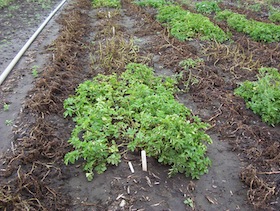UW scientists probe, attack late blight in potatoes
As the annual potato harvest begins, Wisconsin farmers continue to check their fields for late blight, the ferocious plant disease that caused the 1848 Irish potato famine and fueled massive emigration from Ireland.
The cooler, damper conditions that started in August are conducive to late blight in potatoes, says assistant professor Amanda Gevens, who has joint appointments with University of Wisconsin-Extension and the UW–Madison Department of Plant Pathology. She cautions that the latest highly pathogenic strain, called US-23, can destroy a field within a week.

This photo, taken three weeks after inoculation with late blight, shows green plants that carry the RB resistance gene, alongside dead plants which do not. Photo: Dennis Halterman/USDA
When scouts detect the characteristic lesions — or even when late blight is rumored to be in the area — growers must reevaluate methods for limiting disease, including irrigation and the selection and timing of fungicides. They may harvest early to get the crop out of harm’s way.
“Late blight infects any aboveground tissue,” says Gevens. “Below ground, it does little damage to true roots, but it can infect the tubers. And it can devastate entire fields.”
Her particular nightmare is the potential that two strains of late blight can sexually combine to produce a spore that survives in the soil over the winter. However, those strains have not yet appeared at the same time and place in Wisconsin.
Current outbreaks are seeded by infected seed potatoes, infected volunteer potatoes, infected tomato transplants, or spores that blow in during the growing season.
In 2011, Wisconsin was the nation’s No. 4 potato producer, growing 2.2 billion pounds on 62,000 acres. So far, Gevens says, this year’s yields are good.
Late blight also affects tomatoes. It is caused by the fungus-like microorganism Phytophthora infestans, a member of a large group of plant pathogens that can infect a wide range of trees, vegetables and fruits.
At UW–Madison, the nation’s largest group of potato researchers is seeking a weak link in a ferocious adversary. They are advising farmers of best disease management practices, characterizing new late blight strains, and looking at the fundamental genetics and biochemistry of late blight resistance in the potato.
Amy Charkowski in the Department of Plant Pathology runs the Wisconsin Seed Potato Certification Program, which ensures that seed potatoes are disease-free, and oversees the state seed potato farm near Rhinelander.
Gevens, through UW-Extension, provides expert advice on disease management in potatoes and vegetables and coordinates Blitecast, a prediction model that warns farmers when conditions are ripe for blight. “This system integrates our knowledge of the pathogen and capabilities of fungicides for enhanced late blight control in Wisconsin,” says Gevens.
“Unfortunately, society does not currently accept genetic engineering for potatoes and most vegetable crops, even though we have it almost 100 percent in soy and corn.”
Jiming Jiang
Jiming Jiang, a professor of horticulture, helped identify a resistance gene called “RB” in 2003. RB comes from a distant potato relative that cannot cross-breed with commercial potatoes, so it must be transferred through genetic engineering. Although this process has produced experimental varieties with strong resistance to blight, Jiang says, “Unfortunately, society does not currently accept genetic engineering for potatoes and most vegetable crops, even though we have it almost 100 percent in soy and corn.”
Jiang warns that late blight could get bad enough to force another look at genetically modified potatoes. In the meantime, he uses the system “as a model to understand the fundamentals of disease resistance, to understand why a plant that contains a single gene from a wild potato can fend off every strain of the pathogen.”
One resistance gene is not a permanent solution to late blight, cautions Dennis Halterman, a U.S. Department of Agriculture geneticist who works in the Vegetable Crops Research Unit in Madison and collaborates with Gevens and Jiang on late blight research. “Late blight has been able to overcome a lot of resistance genes. In the 1950s and ’60s, people thought this resistance could solve the problem, but in four or five years, late blight had wiped them out.”
“We know strains of Phytophthora in Central America and Mexico can overcome RB already,” says Halterman.
Halterman is looking at a molecule called IPI-O in Phytophthora that can turn off RB, and seems to be ubiquitous in late blight. “We believe Phytophthora needs IPI-O to cause disease,” Halterman says. “If we can target that molecule, we think that would lead to broad spectrum resistance.”
Growers continue to battle late blight through use of varietal tolerance when available and appropriately timed and selected fungicides. However, Phytophthora continues to evolve to survive new threats. The UW potato scientists warn about the future for potatoes. “Genetic engineering provides the best hope for long-term late blight resistance,” says Halterman.
Tags: research



